Jovian - Study guides, Class notes & Summaries
Looking for the best study guides, study notes and summaries about Jovian? On this page you'll find 105 study documents about Jovian.
Page 2 out of 105 results
Sort by
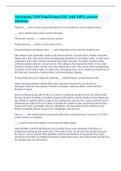
-
Astronomy 1010 Final Exam GSU with 100% correct solutions
- Exam (elaborations) • 6 pages • 2023
- Available in package deal
-
- $7.99
- 1x sold
- + learn more
Planetary ___ have common plane and direction, low eccentricity; correct answers orbits ___shows similar order; correct answers Rotation Moons have similar ___. correct answers motions Orbital spacing ___random. correct answers not Terrestrial and Jovian planets show ___ and composition correct answers trends in size The collapse of an interstellar cloud. As the cloud contracts, it rotates faster, and the outer parts flatten into a disk. This can be observed happening elsewhere in...
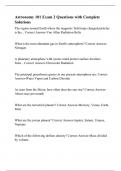
-
Astronomy 101 Exam 2 Questions with Complete Solutions
- Exam (elaborations) • 8 pages • 2024
-
- $16.99
- + learn more
The region around Earth where the magnetic field traps charged particles is the... Correct Answer-Van Allen Radiation Belts What is the most abundant gas in Earth's atmosphere? Correct Answer-Nitrogen A planetary atmosphere with ozone could protect surface dwellers from... Correct Answer-Ultraviolet Radiation The principal greenhouse gasses in our present atmosphere are: Correct Answer-Water Vapor and Carbon Dioxide As seen from the Moon, how often does the sun rise? Correct Answer-...
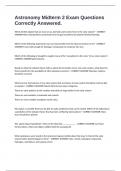
-
Astronomy Midterm 2 Exam Questions Correctly Answered.
- Exam (elaborations) • 33 pages • 2024
-
Available in package deal
-
- $12.99
- + learn more
Astronomy Midterm 2 Exam Questions Correctly Answered. When did the objects that we now see as asteroids and comets form in the solar system? - CORRECT ANSWER After solid particles condensed from the gas but before the planets finished forming. Which of the following statements was true beyond the frost line (but not interior to it)? - CORRECT ANSWER It was cold enough for hydrogen compounds to condense into ices. Which of the following is thought to explain many of the "exceptions t...
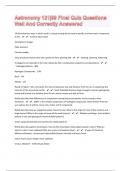
-
Astronomy 121|99 Final Quiz Questions Well And Correctly Answered|2024
- Exam (elaborations) • 12 pages • 2024
-
- $8.49
- + learn more
14) Describe four ways in which earth is unique among the terrestrial worlds, and how each is important to life. - ️️Surface liquid water Atmospheric oxygen Plate tectonics Climate stabilty 3 key processes that led the solar system to form spinning disk - ️️Heating, Spinning, Flattening 4 categories of materials in the solar nebula by their condensation properties and abundance - ️️Hydrogen/Helium - 98% Hydrogen Compounds - 1.4% Rock - .4% Metals - .2% Based on figure 7.48, ...
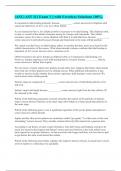
-
(ASU) AST 111 Exam 3 || with Errorless Solutions 100%.
- Exam (elaborations) • 9 pages • 2024
-
Available in package deal
-
- $11.29
- + learn more
Io experiences tidal heating primarily because __________. correct answers Io's elliptical orbit causes the tidal force on Io to vary as it orbits Jupiter. As you learned in Part A, Io's elliptical orbit is necessary to its tidal heating. This elliptical orbit, in turn, is a result of the orbital resonance among Io, Europa, and Ganymede. This orbital resonance causes Io to have a more elliptical orbit than it would otherwise, because __________. correct answers Io periodically passes Europa...

-
ASTRO 7 , 8, 9 ,10, 11 questions n answers graded A+ 2024
- Exam (elaborations) • 7 pages • 2024
-
Available in package deal
-
- $12.99
- + learn more
ASTRO 7 , 8, 9 ,10, 11What are the four major features of our solar system that provide clues to how it formed? Describe each one briefly. - correct answer Patterns of motion among large bodies, Two types of planets, asteroids and comets, exceptions to the rules. What are the basic differences between the terrestrial and jovian planets? Which planets fall into each group? - correct answer Terrestrial planets are small and dense with rocky surfaces and abundant metals in the core: Earth, Mars,...
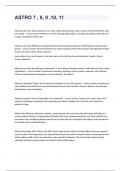
-
ASTRO 7 , 8, 9 ,10, 11 questions with answers 2024
- Exam (elaborations) • 7 pages • 2024
-
- $12.99
- + learn more
ASTRO 7 , 8, 9 ,10, 11What are the four major features of our solar system that provide clues to how it formed? Describe each one briefly. - correct answer Patterns of motion among large bodies, Two types of planets, asteroids and comets, exceptions to the rules. What are the basic differences between the terrestrial and jovian planets? Which planets fall into each group? - correct answer Terrestrial planets are small and dense with rocky surfaces and abundant metals in the core: Earth, Mars,...
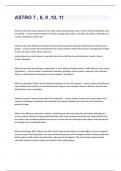
-
ASTRO 7 , 8, 9 ,10, 11 Question and answers 2024 verified to pass
- Exam (elaborations) • 7 pages • 2024
-
Available in package deal
-
- $12.99
- + learn more
ASTRO 7 , 8, 9 ,10, 11 Question and answers 2024 verified to passASTRO 7 , 8, 9 ,10, 11 What are the four major features of our solar system that provide clues to how it formed? Describe each one briefly. - correct answer Patterns of motion among large bodies, Two types of planets, asteroids and comets, exceptions to the rules. What are the basic differences between the terrestrial and jovian planets? Which planets fall into each group? - correct answer Terrestrial planets are small and ...

-
AST101 Clicker Quizzes UofT with 100% Correct Answers
- Exam (elaborations) • 19 pages • 2024
-
- $13.49
- + learn more
AST101 Clicker Quizzes UofT with 100% Correct Answers What does the term "Solar System" mean? - Answer- The Sun, the planets, and all of their moons What does the term "Universe" mean? - Answer- The totality of all space, time, energy, and matter Earth is 1 AU from the Sun. What is the maximumpossible separation between Earth and Mars? (Hint: Mars is the next farthest planet from the Sun) - Answer- 2.5 AU A 'light year' is a measure of: - Answer- distance Stars are... -...

-
AST101 Clicker Quizzes UofT with 100% Correct Answers
- Exam (elaborations) • 19 pages • 2024
-
- $12.49
- + learn more
AST101 Clicker Quizzes UofT with 100% Correct Answers What does the term "Solar System" mean? - Answer- The Sun, the planets, and all of their moons What does the term "Universe" mean? - Answer- The totality of all space, time, energy, and matter Earth is 1 AU from the Sun. What is the maximumpossible separation between Earth and Mars? (Hint: Mars is the next farthest planet from the Sun) - Answer- 2.5 AU A 'light year' is a measure of: - Answer- distance Stars are... - Answer- bal...

$6.50 for your textbook summary multiplied by 100 fellow students... Do the math: that's a lot of money! Don't be a thief of your own wallet and start uploading yours now. Discover all about earning on Stuvia


